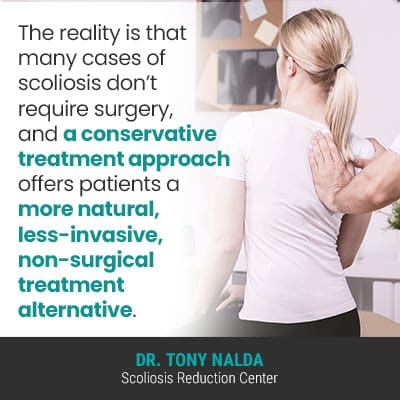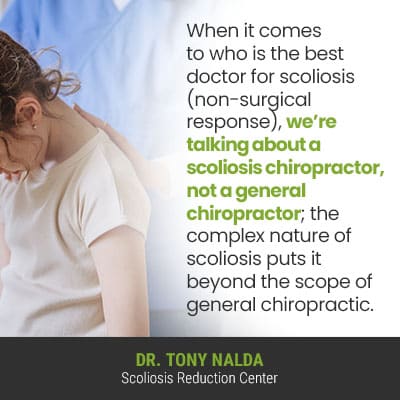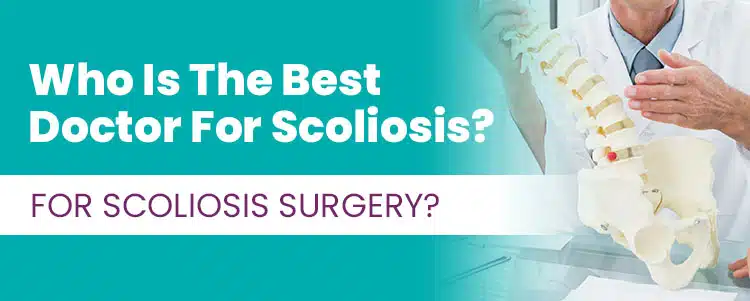As a progressive and incurable condition, how a diagnosis of scoliosis is responded to with treatment will have far-reaching effects. There are different ways to treat scoliosis, each offering patients a different potential outcome that affects the spine differently. Continue reading to learn how to select the best doctor for surgical and non-surgical scoliosis treatment.
The best doctor for scoliosis will depend on the chosen treatment approach. The two main scoliosis treatment approaches are traditional and conservative. The former will require an orthopedic surgeon, while the latter offers a non-surgical alternative delivered by a scoliosis chiropractor.
With close to seven million people living with scoliosis in the United States alone, scoliosis is a highly-prevalent spinal condition that people need to be aware of.
How is Scoliosis Diagnosed?
A scoliosis diagnosis means an unnatural sideways spinal curve, with rotation, has developed, and the rotational component means the spine doesn’t just bend unnaturally to the side, but also twists from back to front, front to back.
A scoliotic curve also has to be of a minimum size to be considered a true scoliosis: minimum Cobb angle measurement of at least 10 degrees.
It’s hard to talk about scoliosis without mentioning Cobb angle; it’s a measurement that’s become the gold standard in the diagnosis and assessment of scoliosis.
A patient’s Cobb angle is determined during X-ray and involves drawing intersecting lines from the tops and bottoms of the curve’s most-tilted vertebrae, and the resulting angle is expressed in degrees.
The higher the Cobb angle, the more severe the condition, the more likely continued progression is, and the more likely it is that the condition’s effects are going to be noticeable:
- Mild scoliosis: Cobb angle measurement of between 10 and 25 degrees
- Moderate scoliosis: Cobb angle measurement of between 25 and 40 degrees
- Severe scoliosis: Cobb angle measurement of 40+ degrees
- Very-severe scoliosis: Cobb angle measurement of 80+ degrees
In a healthy spine, the vertebrae (bones of the spine) are aligned, but in a scoliotic spine, some vertebrae have become unnaturally tilted, causing the spine to become misaligned, and this disrupts the biomechanics of the entire spine.
So the goal of treatment is to realign the spine so the condition’s uneven forces are reduced while the curve is being reduced.
Now, a key condition characteristic to understand is that as a progressive condition, scoliosis has it in its very nature to get worse over time, and this means that where a scoliosis is at the time of diagnosis isn’t indicative of where it will stay, especially without proactive treatment.
Now, let’s talk about the two main scoliosis treatment approaches, and how to select the best doctor for each.
Scoliosis Treatment Options
As mentioned, there are two main scoliosis treatment approaches for patients to choose between: traditional and conservative.
Traditional treatment offers a reactive surgical response to a diagnosis of scoliosis, while modern conservative treatment responds proactively and offers a non-surgical treatment alternative.
Traditional Scoliosis Treatment
Those on the path of traditional treatment will need to find an experienced orthopedic surgeon who specializes in the surgical treatment of spinal conditions like scoliosis.
While neurosurgeons can perform spinal surgery, it’s common that neurosurgeons split their speciality between the brain and the spine, and whenever possible, particularly when it comes to risky spinal surgery, I recommend finding a surgeon with a single-focused specialty on spinal surgery.
As a complex condition, scoliosis necessitates a fully customized treatment approach, and an orthopedic surgeon with a focus on performing scoliosis surgery (spinal fusion) is going to be one that is prepared for the condition’s complexities.
While all surgical procedures come with their share of risks, spinal fusion is a costly and invasive procedure that carries some heavy potential risks, side effects, and complications.
Spinal fusion involves fusing the most-tilted vertebrae at the curve’s apex into one solid bone, and this is done to eliminate movement (progression) in the area; in other words, as they are fused together, they can’t become more tilted.
Rods are commonly attached to the spine with pedicle screws to hold it in place, and hardware attached is permanent; a fused spine is a fused spine for life.
While spinal fusion can help straighten a bent spine, the way it does so is contrary to the spine’ movement-based design, and many patients experience a noticeable loss in spinal flexibility and range of motion that affects overall quality of life.
A fused spine is also more vulnerable to injury, and that knowledge can psychologically affect patients who describe a fear of trying new things, or even participating in once-loved activities.

The reality is that many cases of scoliosis don’t require surgery, and a conservative treatment approach offers patients a more natural, less-invasive, non-surgical treatment alternative.
Conservative Scoliosis Treatment
For those choosing to forego a surgical recommendation, or who simply want to try a less-invasive form of treatment first, conservative chiropractic-centered treatment has proven results.

When it comes to who is the best doctor for scoliosis (non-surgical response), we’re talking about a scoliosis chiropractor, not a general chiropractor; the complex nature of scoliosis puts it beyond the scope of general chiropractic.
Just as I recommend finding a surgeon who specializes in scoliosis surgery, those looking to try conservative scoliosis treatment need to also find a chiropractor who specializes in scoliosis.
As a CLEAR-certified scoliosis chiropractor, I know the spine, I know scoliosis, and I know how the spine responds to different types of treatment.
Not only does scoliosis range widely in severity from mild to moderate and severe to very severe, it can affect all ages, develop in any of the spine’s main sections, and there are multiple different types of scoliosis, each with its own unique characteristics and treatment needs.
So as you can see, a doctor could likely dedicate their whole career to learning about scoliosis, with still more to learn; this is why the best doctor for scoliosis is always a specialist with years of training and experience in a patient’s chosen treatment approach.
Here at the Scoliosis Reduction Center®, I provide patients with access to multiple different types of scoliosis treatment under one roof; this allows me to fully customize each and every treatment plan based on the specific characteristics of each patient’s condition.
I combine condition-specific chiropractic care, physical therapy, corrective bracing, and rehabilitation so conditions can be impacted on every level.
Chiropractic care is used to impact the condition on a structural level, and as a structural condition, this is precisely where treatment needs to be focused.
Through a series of chiropractic techniques and adjustments, I can work towards adjusting the position of the curve’s most-tilted vertebrae back into alignment with the rest of the spine, and this curvature reduction restores as much of the spine’s healthy curves as possible.
After I’ve impacted the condition on a structural level, I can shift the focus of treatment to increasing core strength through physical therapy so the spine’s surrounding muscles can provide it with optimal support/stabilization.
Physical therapy can also help with postural remodeling and activating certain areas of the brain for improved brain-body communication and a more-natural body positioning.
When it comes to correcting scoliosis in patients whose spines are still growing, corrective bracing can be particularly effective by pushing the spine into a corrective position.
Rehabilitation involves guidance on how to lead a scoliosis-friendly lifestyle and a series of custom-prescribed home exercises to help patients establish a home-rehabilitation program for further stabilizing the spine.
Conclusion
When patients are diagnosed with scoliosis, they are naturally flooded with questions and concerns, one of which is how to find the best doctor to guide them on their scoliosis journey.
Dr. Tony Nalda is trained and certified in multiple different scoliosis treatment modalities, making him a leading conservative scoliosis treatment provider.
At the Center, Nalda has been helping patients avoid the potential complications and side effects of invasive spinal surgery for over 20 years, and he does this by providing a non-surgical form of treatment that works to preserve as much of the spine’s natural strength and function as possible.
Ultimately, the best doctor for scoliosis is one who makes their patients comfortable and confident, and one whose treatment approach is aligned with the patient’s desired outcome.
For those wanting to avoid the potential complications of life with a fused spine, a conservative scoliosis chiropractor with experience and training on their side is the best doctor for scoliosis, and for those looking for a surgical treatment response, an orthopedic surgeon who specializes in scoliosis surgery is likely to offer the best potential surgical results.
The most important thing to understand about scoliosis is that the best time to start treatment is always now; scoliosis only gets more complex to treat as it progresses, and while there are never treatment guarantees, early detection and intervention is associated with higher rates of treatment efficacy.




